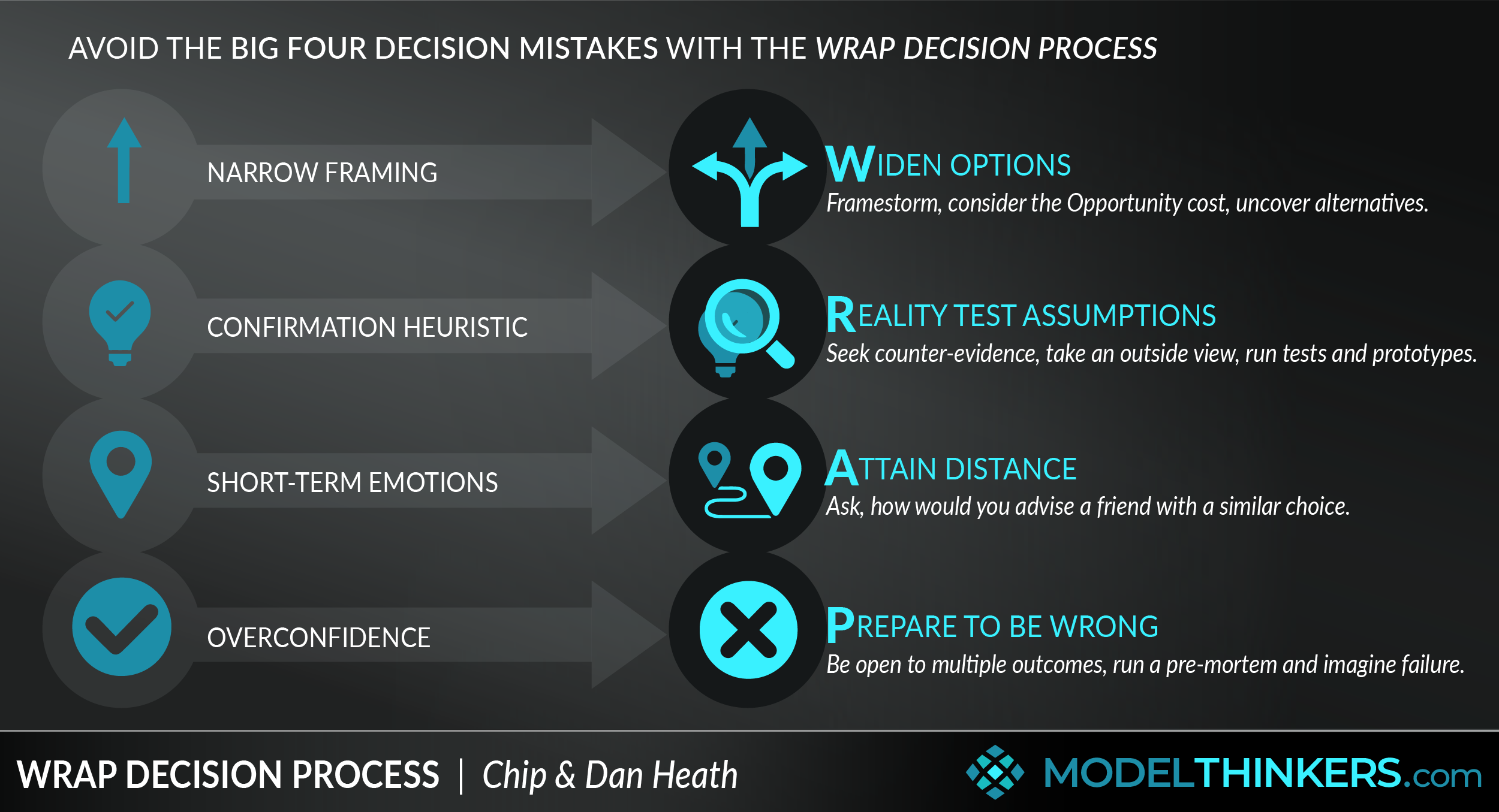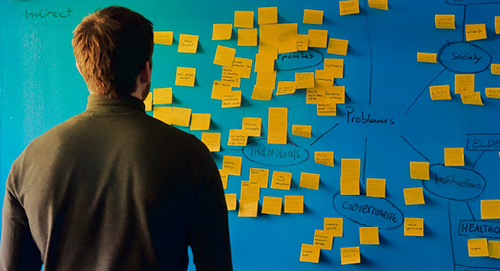

 0 saved
0 saved
 43.7K views
43.7K views








In their best-selling book Decisive, Chip and Dan Heath identified ‘four villains of decision-making’, these are the common pitfalls that we fall into when making a choice. Their resulting decision-making process aims to avoid these villains and empower better decisions.
The WRAP Decision Process includes: Widening your options to avoid narrow framing; Reality testing your assumptions to avoid the Confirmation Heuristic; Attaining distance to avoid short-term emotions; and Preparing to be wrong to avoid overconfidence.
WHY WRAP?
We were immediately drawn to this model because it effectively applies the Inversion approach, one of our favourite models, to decision-making. In other words, rather than obsessing about making great decisions, WRAP empowers you to avoid making bad ones.
In arguing for their model, the Heath brothers note that people tend to overestimate the impact of analysis over the power of an effective decision-making process. They explain: “When the researchers compared whether process or analysis was more important in producing good decisions—those that increased revenues, profits, and market share—they found that “process mattered more than analysis—by a factor of six.
"Often a good process led to better analysis—for instance, by ferreting out faulty logic. But the reverse was not true: Superb analysis is useless unless the decision process gives it a fair hearing.”
APPLYING WRAP.
We know you’re busy, so we’ve distilled the WRAP Decision Process into this quick reference table for you:
|
DECISION-MAKING CHALLENGES |
WRAP DECISION PROCESS |
PRACTICAL TECHNIQUES |
|
Narrow framing: We have a tendency to just consider two counterposed choices. |
Widen the frame: Work to uncover new options that shift the conversation from choosing “This OR That’ to can we do “This AND That.” |
|
|
Confirmation Heuristic: |
Reality-test your assumptions: Ask questions to challenge your current assumptions and seek other perspectives. |
|
|
Short-term emotions: We are less rational than we believe and our physical and emotional state have massive impacts on decisions. |
Attain distance before deciding: Aim to gain a greater perspective or view of the challenge before deciding. |
|
|
Overconfidence: We tend to believe that things will turn out as we plan. |
Prepare to be wrong: |
|
SETTING TRIPWIRES.
The Heath Brothers implicitly advocate Fast and Slow Thinking and acknowledge that we will generally make irrational, fast decisions left to our own devices. They, therefore, suggest setting ‘tripwires’ which are a form of Nudges to encourage us to focus on decisions more consciously at key moments. They cite the example of Zappos which offers their employees $400 to quit during their induction process, this temptation is a tripwire to force an early decision point for less motivated employees.
IN YOUR LATTICEWORK.
The WRAP Decision Process has connections to many other models and frameworks as you can see from the many links above. WRAP is a form of Inversion in that it avoids the worst of decision-making. In addition, when applying WRAP you can use:
-
Framestorming and Opportunity Costs to help widen your focus;
-
Rolestorming and Prototyping to challenge your Confirmation Heuristics;
-
Advice Giving Effect and Jeff Bezos’ Regret Minimisation Framework to challenge short-term emotions;
-
And Probabilistic Thinking, Inversion (premortems) and Redundancy or a Margin of Error to challenge overconfidence.
Beyond those models consider applying the WRAP Process in combination with Dave Snowden’s Cynefin Framework to identify the level or nature of complexity you are facing, or as an overlay to Decision Trees.




-
Remember to slow down for key decisions.
Behavioural economics has provided considerable evidence as to our irrationality in decision-making so ensure that you slow down when faced with a decision and apply a process such as WRAP.
-
Widen the frame.
Actively Framestorm the question and uncover other options that go beyond the choice at hand. Consider whether there are any combinations or new approaches to solving your problem.
-
Reality test your assumptions.
Challenge your Confirmation Heuristic by asking what would you see if you were wrong and actively seeking out counter-evidence. You might also want to run experiments with Prototypes.
-
Attain distance before deciding.
Go beyond short-term emotions by asking yourself how you’d advise a friend in a similar situation, or applying Jeff Bezos’ Regret Minimisation Framework.
-
Prepare to be wrong.
Apply Probabilistic Thinking to consider multiple possible futures, use Inversion and pre-mortems to and plan with Redundancy or a Margin of Error.
There is a growing acceptance of our innate irrationality and the Heath brother's WRAP Decision Process sets out to mitigate against some of the most impactful challenges that we all face when making decisions. That said, knowing about our irrational decision-making does not solve the problem, and perhaps the biggest challenge of this process is having the presence of mind to use it in our daily lives. The Heaths try to address this potential fail point with their 'trip wire' concept, which is essentially nudges, to slow down decisions, but it remains an issue.
WRAP examples.
Some of the examples that the Heath brothers cite in support of the WRAP Decision Process include:
-
Widening the Frame: A study where two groups of graphic designers were charged to create a banner advert. One group created a single advert at a time while the other group created three versions concurrently. The second group were assessed as delivering better results.
-
Reality test: the Heaths suggest when checking to see if you want to take a job at a firm, consider questions to challenge assumptions including asking people who work there how often they have dinner at home, are they happy, do they work nights etc..
-
Prepare to be wrong: the Heaths note that elevator cables are typically eleven times stronger than they need to be.
d
The WRAP Decision Process was created by Chip and Dan Heath and forms the basis for their book Decisive, How to Make Better Choices in Life and Work.
They explain the driver behind the model: “You encounter a choice. But narrow framing makes you miss options. You analyze your options. But the confirmation bias leads you to gather self-serving information. You make a choice. But short-term emotion will often tempt you to make the wrong one. Then you live with it. But you’ll often be overconfident about how the future will unfold.”
 My Notes
My Notes
Oops, That’s Members’ Only!
Fortunately, it only costs US$5/month to Join ModelThinkers and access everything so that you can rapidly discover, learn, and apply the world’s most powerful ideas.
ModelThinkers membership at a glance:






“Yeah, we hate pop ups too. But we wanted to let you know that, with ModelThinkers, we’re making it easier for you to adapt, innovate and create value. We hope you’ll join us and the growing community of ModelThinkers today.”





















































































